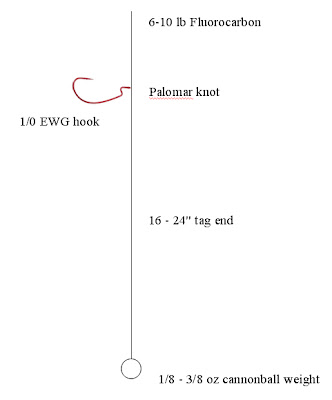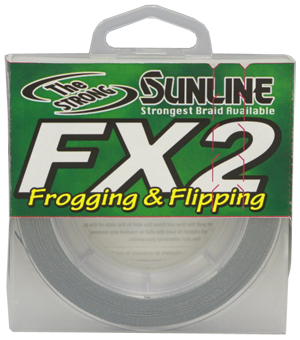Continuing on from our dropshotting technique...I would like to introduce you to two more techniques! The Flickshake and the Shakey head! Both techniques can be fished on your dropshot/finesse rod and are awesome techniques to have in your back pocket when the bass go into lock jaw mode and need a finesse presentation to trigger strikes!
The Flickshake
The Flickshake technique utilizes a very crucial technique that most anglers have run into at least once in their lifetime...the wacky worm rig. The wacky worm rig is one of my go to rigs in the late spring, summer, and fall and works wonders when you are fishing in shallow areas with sparse cover. The slow decent on a weightless wacky rig is irresistable to a bass, and the flickshake is the same thing only using a jig head instead of a regular hook. Flickshakes, like other finesse presentations, are meant to be fished slow. Sudden twitches of the rod will bring the lure off of the bottom quickly and will then make a quick fall. Pausing periodically and varying the power in your twitches will allow your lure to wiggle at different heights and rates, thus triggering a strike.
The flickshake jig head comes in two common styles, one with and one without a wire weed gaurd. For simplicity sake, I like having the ones with the weedgaurd already attached so that I can fish in heavier cover areas more effectively. The lighter the weight jig head the slower the fall, since I am used to fishing lures mostly weightless I tend to go with a lighter flickshake head since I have more confidence in it. The jig head also helps to elevate the worm slightly off the bottom allowing the bass to inhale the lure more easily.
What type of lures do I use with a flickshake?
Straight worms like a Senko or other uniform type worms work really well with this bait. One in particular that I really like using is the Jackall Flick Shake worm. It has a slender profile and has A TON of action when bounced around with the jig head. Other lures like curl tail worms and other straight worms would work as well
Once you have chosen the bait, you would rig the flickshake like you would a wacky worm rig with the hookpoint going through the center or the "collar" of the worm. Here is a good video that gives some more detail on the flickshake rig and what it looks like in action!
The Shakey Head
The Shakey Head rig also is a finesse variant of another popular rig, the Texas Rigged Worm. In this instance the Shakey Head rig allows you to downsize and streamline your presentation without having to worry about pegging bullet weights and having extra terminal tackle. There is one style available that most companies vary their design off of, and that is a round jig head with a screw lock. You can see this jig head below...
The screw lock allows you to screw the head of your bait to the head of the jig, which gives you a secure point to prevent the worm from ripping off easily. All of these jig heads come in different styles, colors, and hook sizes so find what works for you. In my case I try to use a 3/16 or 1/8 oz jig head with a 2/0 or 3/0 hook. This will work the best for most lures.
The lure choices are endless with this bait. Worms with floating tails are the main choice with this jig head...but others may use shad style baits, creature baits, and craw style baits as well. My favorite to use though is either a straight tail worm like the ZOOM Shakey Head worm, or a smaller curly tail worm like a Gambler 7" Ribbontail worm. Both of these worms give off great action at the tail end which is essential when fishing this rig. Both the Shakey Head and Flickshake require you to make the most action possible with the smallest bit of movement. That's what makes a finesse rig so effective...slow moving, high action!
Here are some good videos showing you how the shake head is rigged and how it looks underwater. After spinning and locking the head of the worm to the jig head, you will texas rig the bait like you would on a regular worm hook. A good thing to learn how to do is skin hooking the worm after you penetrate the hookpoint all the way through. This will allow you to fish it virtually weedless without getting hung up. Another good point to bring up is toning down your hookset. You don't have to swing for the fences when setting the hook on a finesse technique. A good pop of the wrist along with a sharp hook will be plenty to penetrate through a fishes mouth. Otherwise you run the risk of pulling the bait out of the fish's mouth or breaking your smaller pound test line.
So when and where do I fish this rig?
Any time you would use a finesse rig would warrant using these baits. Cold fronts, hot summer days, during spawning time, and when water temperatures are dipping down into the 50's or less. When the bass are less active and other presentations aren't working, these will be your ace in the hole to start triggering bites. But keep in mind that these rigs need to be fished slowly with a lot of rod tip action! You are not encouraging a reaction strike in most instances so you want to entice the bass into biting. Take the time to learn this craft, and you will be catching fish when others don't. Shallow areas, flats, boat docks, and areas with some form of vegetation or brush will all be places to be looking for when throwing these baits.
That pretty much sums up what I have experienced, and I plan on using these finesse techniques at my first tournament this season. I look forward to hearing from all of you too to see how these techniques help you throughout the season!
Tight Lines,
Fluke





















